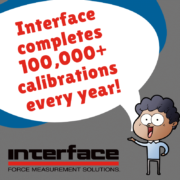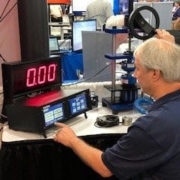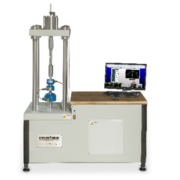Interface Instrumentation Connects Sensors to Actionable Data
 Ever struggled to find the perfect instrument to complement your measurement device? Interface offers a comprehensive instrumentation suite to ensure you maximize the full potential of your load cells, torque transducers, and other sensor investments.
Ever struggled to find the perfect instrument to complement your measurement device? Interface offers a comprehensive instrumentation suite to ensure you maximize the full potential of your load cells, torque transducers, and other sensor investments.
Interface continues to expand our unique range of instrumentation products to complement our measurement devices. Interface instrumentation pairs with our load cells, torque transducers, multi-axis sensors, calibration equipment, and other sensors.
Our instrumentation series is comprehensive and versatile, catering to various measurement needs. We have a solution for every application, from signal conditioners to USB and wireless connectivity output modules, high-speed data loggers, digital and analog indicators, portable indicators and displays, weight indicators, and junction boxes. We also offer full data acquisition (DAQ) wireless telemetry systems and calibration-grade equipment, making us your one-stop shop for testing and measurement needs.
TIP: Use the Interface Instrumentation Selection Guide to help you choose the instrument best suited for your application. Also, check out our convenient Instrumentation Definitions resources.
INTERFACE INSTRUMENTATION PRODUCT REVIEW
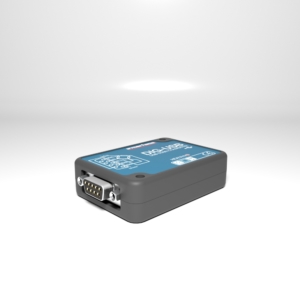 Interface modules are designed to convert the low‐level mV/V sensor signal to a digital format for data transmission via USB, wireless USB, or Bluetooth. They have user-friendly software for easy data display, logging, and graphing. Moreover, our modules’ plug-and-play functionality ensures a hassle-free setup, making them a convenient choice for your instrumentation needs. The following are popular instrumentation modules.
Interface modules are designed to convert the low‐level mV/V sensor signal to a digital format for data transmission via USB, wireless USB, or Bluetooth. They have user-friendly software for easy data display, logging, and graphing. Moreover, our modules’ plug-and-play functionality ensures a hassle-free setup, making them a convenient choice for your instrumentation needs. The following are popular instrumentation modules.
- DIG-USB USB Output Module
- DIG-USB-F Fast USB Output Module
- BSC1-HD Single Channel PC Interface Module with Analog Output
- BSC4A Multi-Channel Analog Output Bridge Amplifier
- BSC2 Dual Channel PC Interface Module
- BX6-BT Portable 6-Channel High-Speed Bluetooth Data Logger
- INF-USB3 Universal Serial Bus Single Channel PC Interface Module
 Signal conditioners provide stable excitation voltage to the sensor and amplify the low-level sensor signal to a high-level output such as +/-5V, +/-10V, 0-20mA, 4-20mA, 0-5V, or 0-10V. When selecting a signal conditioner, it is crucial to consider power supply requirements. Many of our signal conditioner products include filtering, which can help reduce noise in the output signal. It is also important to consider the amount of filtering, fixed or adjustable filtering, input range, scalability, and zero adjustment range.
Signal conditioners provide stable excitation voltage to the sensor and amplify the low-level sensor signal to a high-level output such as +/-5V, +/-10V, 0-20mA, 4-20mA, 0-5V, or 0-10V. When selecting a signal conditioner, it is crucial to consider power supply requirements. Many of our signal conditioner products include filtering, which can help reduce noise in the output signal. It is also important to consider the amount of filtering, fixed or adjustable filtering, input range, scalability, and zero adjustment range.
- CSC and LCSC-OEM In-Line Signal Conditioners
- DMA2 DIN Rail Mount Signal Conditioner
- SGA AC/DC Powered Signal Conditioner
- VSC2 Rugged Compact Vehicle Powered Signal Conditioner
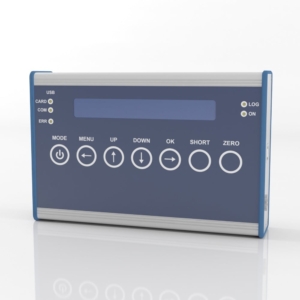 Indicators provide stable excitation voltage and convert the sensor signal to a digital display. We offer a range of transmitters and indicators for weight, force, and torque measurement, as well as a series of portable instrumentation solutions. Standard indicator features include analog or digital output, selectable digital filtering, peak and valley monitoring, and set point outputs. When selecting an indicator, evaluating the internal sample rate and updating the analog output rate is crucial. Interface offers digital and analog indicators. The following are some popular options.
Indicators provide stable excitation voltage and convert the sensor signal to a digital display. We offer a range of transmitters and indicators for weight, force, and torque measurement, as well as a series of portable instrumentation solutions. Standard indicator features include analog or digital output, selectable digital filtering, peak and valley monitoring, and set point outputs. When selecting an indicator, evaluating the internal sample rate and updating the analog output rate is crucial. Interface offers digital and analog indicators. The following are some popular options.
- 9330 Battery-Powered High-Speed Data Logging Indicator
- 9840 Calibration Grade Multi-Channel Load Cell Indicator
- 9840TQ mV/V Input Torque Transducer Indicator
- 9850 Torque Transducer and Load Cell Indicator
- 9870 High-Speed High-Performance TEDS Ready Indicator
- 9325 Portable Sensor Display
- 1280 Programmable Weight Indicator and Controller
- 920i Programmable Weight Indicator and Controller
- 480 Bidirectional Weight Indicator
- 4850 Battery Powered Bluetooth Weight Indicator
- 9890 Strain Gage, Load Cell, and mV/V Indicator
- 9894 Analog Input Process Indicator
- INF1-Analog Single Sensor Weight Transmitter and Indicator (Multiple Communication Options Available)
- INF4-Analog Two, Three, and Four Sensor Weight Transmitter and Indicator (Multiple Communication Options Available)
 Wireless Telemetry System (WTS) instrumentation offers easy‐to‐use wireless data communication between a sensor and a receiving indicator. These system components can receive multiple inputs and are fully compatible with all Interface force sensors. Interface offers wireless transceivers, printers, antennas, DAQ components, data loggers, and transmitter modules. The WTS instrumentation comes calibrated, tested, and ready to run. Bluetooth Telemetry System (BTS) instrumentation and supporting components are also available. Here are some of the wireless devices available. Access our WTS & BTS Telemetry Systems Overview for additional review.
Wireless Telemetry System (WTS) instrumentation offers easy‐to‐use wireless data communication between a sensor and a receiving indicator. These system components can receive multiple inputs and are fully compatible with all Interface force sensors. Interface offers wireless transceivers, printers, antennas, DAQ components, data loggers, and transmitter modules. The WTS instrumentation comes calibrated, tested, and ready to run. Bluetooth Telemetry System (BTS) instrumentation and supporting components are also available. Here are some of the wireless devices available. Access our WTS & BTS Telemetry Systems Overview for additional review.
- 9812-WTS Wireless Panel Mount Display for Single Transmitters
- WTS-BS-1 Wireless Handheld Display For Unlimited Transmitters
- WTS-BS-2 Wireless Base Station with Industrial Interfaces
- WTS-BS-1-HS Wireless Handheld Display for Single Transmitters
- WTS-AM-1E Wireless Strain Bridge Transmitter Module
- WTS-AM-1F Wireless Fast Strain Bridge Transmitter Module
- WTS-AM-3 Wireless 4-20 mA Transmitter Module
- WTS-AM-2 Wireless Voltage Sensor Transmitter
- WTS-BS-5 Wireless Analog Output Receiver Module
- WTS-BS-6 Wireless Telemetry Dongle Base Station
- BSC4D-BT Portable 4-channel Bluetooth Data Logger
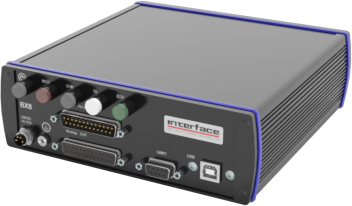 Data Acquisition Systems and Acquisition Modules are components used to acquire data via analog signals and convert them to digital form for storage, logging, graphing, and analysis. Data acquisition systems typically require high-level inputs such as +/-10V and cannot work well with low-level mV signals. Interface offers instruments and DAQ systems designed to work with low-level mV signals. A complete data acquisition system consists of DAQ hardware, sensors and actuators, signal conditioning hardware, and a computer running DAQ software. Interface provides DAQ instrumentation that is ideal for completing a sensor-based system. Check out Data Acquisition Systems 101. The following are examples of our DAQ instrumentation.
Data Acquisition Systems and Acquisition Modules are components used to acquire data via analog signals and convert them to digital form for storage, logging, graphing, and analysis. Data acquisition systems typically require high-level inputs such as +/-10V and cannot work well with low-level mV signals. Interface offers instruments and DAQ systems designed to work with low-level mV signals. A complete data acquisition system consists of DAQ hardware, sensors and actuators, signal conditioning hardware, and a computer running DAQ software. Interface provides DAQ instrumentation that is ideal for completing a sensor-based system. Check out Data Acquisition Systems 101. The following are examples of our DAQ instrumentation.
- BX8-AS BlueDAQ Series Data Acquisition System with Industrial Enclosure
- BX8-HD15 BlueDAQ Series Data Acquisition System for Discreet Sensors with Lab Enclosure
- BX8-HD44 BlueDAQ Series Data Acquisition System for Multi-Axis Sensors with Lab Enclosure
- BSC4D Multi-Channel Digital PC Interface and Data Acquisition Instrument
 Junction boxes are commonly used in weighing applications where a tank or scale is supported by more than one load cell. The individual load cell cables are wired into the junction box, and then a single cable connects the junction box to the instrumentation. Our multi-function weight transmitter junction box has a compact design and signal-conditioning functions.
Junction boxes are commonly used in weighing applications where a tank or scale is supported by more than one load cell. The individual load cell cables are wired into the junction box, and then a single cable connects the junction box to the instrumentation. Our multi-function weight transmitter junction box has a compact design and signal-conditioning functions.
- JB104SS 4-Channel Stainless Steel Junction Box
- JB1100 4-Channel Advanced Signal Conditioning Transmitter Indicator and Junction Box
In addition to our most popular instrumentation types, Interface also offers repeater modules, load cell converters, Modbus instrumentation, LED displays, and products for remote data collection. We can provide environmentally protected instrumentation solutions and complete system set-up and calibration. To learn more, review the Instrumentation Solutions Overview.
Instrumentation Tech Talk
A Wheatstone bridge-based sensor, such as a load cell, requires excitation voltage. The excitation voltage is typically 10V; however, many instruments supply lower voltages, such as 2.5V and 5V. Since these sensors are ratiometric, our instrumentation solutions are an excellent match for these sensor products.
The output signal from a load cell is expressed in terms of mV output per V of excitation at capacity. For example, a 100 lb capacity load cell rated for 2 mV/V output will have 20 mV output at 100 lbf when excited with 10V. Because the output signal is directly affected by input voltage, it’s essential to maintain a stable excitation voltage, which our instrumentation does. A signal can also be a voltage or mA signal as well.
Interface offers instrumentation solutions for all types of applications, from signal conditioners to wireless data loggers. It is a one-stop shop for complete measurement solutions.
ADDITIONAL RESOURCES
The Convenience of Interface Portable Instrumentation Devices
Ultimate BlueDAQ Software Guide for Interface Instrumentation
Interface Instrumentation Definitions
Introducing New Interface Instrumentation Selection Guide
Advancements in Instrumentation Webinar

